

Freebies for the Rich. Max Russell had always been a conscientious student, but when his father died during his junior year of high school, he had to take on a 25-hour-per-week job to help his family pay the bills.
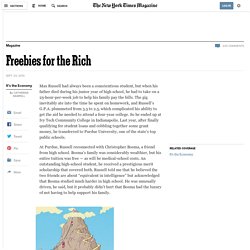
The gig inevitably ate into the time he spent on homework, and Russell’s G.P.A. plummeted from 3.5 to 2.5, which complicated his ability to get the aid he needed to attend a four-year college. So he ended up at Ivy Tech Community College in Indianapolis. Last year, after finally qualifying for student loans and cobbling together some grant money, he transferred to Purdue University, one of the state’s top public schools. At Purdue, Russell reconnected with Christopher Bosma, a friend from high school. Bosma’s family was considerably wealthier, but his entire tuition was free — as will be medical-school costs. Photo Over the years, many state-university systems — and even states themselves — have shifted more of their financial aid away from students who need it toward those whose résumés merit it. Janet Gornick on Income Inequality. This map shows where the world’s 30 million slaves live. There are 60,000 in the U.S.
Share of each country's population that is enslaved.
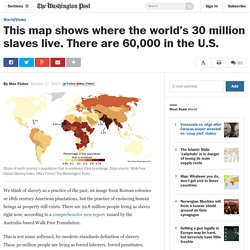
Click to enlarge. Data source: Walk Free Global Slavery Index. (Max Fisher/The Washington Post) We think of slavery as a practice of the past, an image from Roman colonies or 18th-century American plantations, but the practice of enslaving human beings as property still exists. There are 29.8 million people living as slaves right now, according to a comprehensive new report issued by the Australia-based Walk Free Foundation. This is not some softened, by-modern-standards definition of slavery. The country where you are most likely to be enslaved is Mauritania. Wealth And Income Inequality In America. US income inequality at record high. 10 September 2013Last updated at 15:06 ET One street in St Louis, Missouri, has been known to residents as the "dividing line" The income gap between the richest 1% of Americans and the other 99% widened to a record margin in 2012, according to an analysis of tax filings.

The top 1% of US earners collected 19.3% of household income, breaking a record previously set in 1927. Income inequality in the US has been growing for almost three decades. A Rise in Wealth for the Wealthy; Declines for the Lower 93% An Uneven Recovery, 2009-2011 By Richard Fry and Paul Taylor During the first two years of the nation’s economic recovery, the mean net worth of households in the upper 7% of the wealth distribution rose by an estimated 28%, while the mean net worth of households in the lower 93% dropped by 4%, according to a Pew Research Center analysis of newly released Census Bureau data.
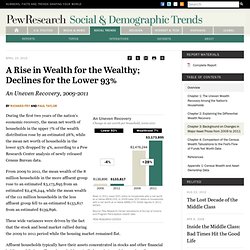
Wealth gap and Congress. Notes on the wealth gap and Congressional wealth.
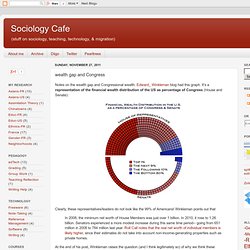
Edward_ Winkleman blog had this graph. It's a representation of the financial wealth distribution of the US as percentage of Congress (House and Senate): Clearly, these representatives/leaders do not look like the 99% of Americans! Winkleman points out that In 2008, the minimum net worth of House Members was just over 1 billion.
At the end of his post, Winkleman raises the question (and I think legitimately so) of why we think these representatives/leaders, given their wealth bracket, should care about the "99%" since voting to raise taxes on the wealthiest likely means a vote to raise taxes on themselves... No Rich Child Left Behind. Javier Jaén Here’s a fact that may not surprise you: the children of the rich perform better in school, on average, than children from middle-class or poor families.
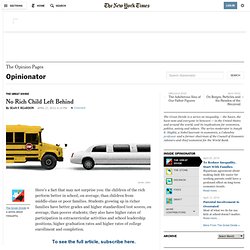
Students growing up in richer families have better grades and higher standardized test scores, on average, than poorer students; they also have higher rates of participation in extracurricular activities and school leadership positions, higher graduation rates and higher rates of college enrollment and completion. Whether you think it deeply unjust, lamentable but inevitable, or obvious and unproblematic, this is hardly news. It is true in most societies and has been true in the United States for at least as long as we have thought to ask the question and had sufficient data to verify the answer. What is news is that in the United States over the last few decades these differences in educational success between high- and lower-income students have grown substantially.
If not the usual suspects, what’s going on? Sean F.